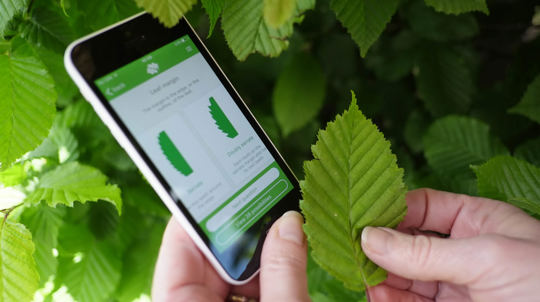
Credit: Colin Varndell / naturepl.com
Leaves
Leaf buds are rounded and green, like little peas, and form on short leaf stalks. The lobed leaves are similar to maple, and turn a rich, coppery red before falling in autumn.
A true springtime stunner, it’s not so long ago that you could find wild-service fruit at a market. These days it’s rare and hard to find but it’s still a favourite with wildlife like the wood pigeon, whose gut softens its seeds for propagation.
Common name: wild service tree
Scientific name: Sorbus torminalis
Family: Rosaceae
Origin: native
This deciduous broadleaf tree can reach 25m when mature. The bark is brown and patterned with cracked, square plates, and the twigs are slender, shiny, grey-brown and straight.
Look out for: the leaves which have 3–4 unequal lobes.
Identified in winter by: the green buds, which are not hairy.

Credit: Colin Varndell / naturepl.com
Leaf buds are rounded and green, like little peas, and form on short leaf stalks. The lobed leaves are similar to maple, and turn a rich, coppery red before falling in autumn.

Credit: Bob Gibbons / Alamy Stock Photo
The wild service tree is hermaphrodite, meaning both male and female reproductive parts are contained within each flower. They form in clusters in late spring to early summer, and are pollinated by insects.

Credit: WILDLIFE Gmbh / Alamy Stock Photo
Once pollinated, the flowers develop into green-brown oval fruits (sometimes called chequers), 10–15 mm diameter and patterned with small, pale spots when mature in mid to late autumn. It can also propagate itself by suckers.
Maple (Acer campestre) as they have similarly shaped leaves, but those of the wild service tree are not as distinctly lobed.
The fruit require 'bletting' (ie. decomposition) through freezing to make them edible.
Although rare, it is often found in oak and ash woods and pockets of ancient woodland. It grows best in clay and lime-based soils. The wild service tree is native to the UK and parts of Europe, Africa and Asia.

The wild service tree is an ancient-woodland indicator. If you spot it while you're out exploring, it could be a sign you're standing in a rare and special habitat.
Learn more about ancient woodlandThe flowers provide pollen and nectar for insects, while the berries are eaten by birds. The leaves are eaten by caterpillars of the moths Bucculatrix bechsteinella and Phyllonorycter mespilella.
Chequers were still on sale around 100 years ago.
The fruits, also known as chequers, are said to taste like dates and were given to children as sweets. They can be made into an alcoholic drink and it is thought they influenced the naming of 'Chequers Inns', although it is unclear which came first – the name of the fruit or the inns.
The wood has a fine grain and silvery sheen, although it has never been widely used. The fruits can also be used to flavour other alcoholic drinks, such as whisky.
Trees may be affected by silver leaf disease and fireblight.

Trees woods and wildlife
Our free Tree ID app for Android and iPhone helps you identify the UK's native and non-native trees. It's an A-Z tree guide in your pocket.

Shop
We have single trees and tree packs to meet your needs, from wildlife to woodfuel. Delivery is free.
External link